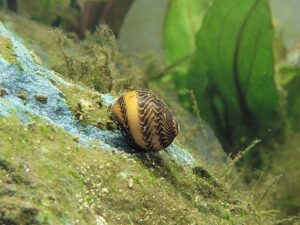
16 Types of Aquarium Snails You Should Have

Writer at The Aquarium Keeper
Aquatic snails can be an exciting addition to an aquarium since there are so many colors and species to choose from. You could probably find a snail for any kind of setup, including darker aquariums, or even brackish water aquariums. In this article, I will break down 15 types of aquarium snails, that you should try to keep, and that are perfectly suitable for beginners. Most of these snails are commonly accessible worldwide, but some are only being introduced to this hobby.
General Guidelines For Keeping Aquarium Snails
Before starting the aquatic snail list, it is important to mention a few general guidelines that every person should know, before keeping aquatic snails. These basic guidelines will help prevent any harm to your snails, and ensure, that they live a happy and comfortable life. Here are the things, that you should know:
- Aquarium snails are sensitive creatures. Most aquatic snails are really sensitive to sudden water parameter changes. Aquatic snails generally don’t have a strong immune system, so a sudden change in water temperature or any other parameter can really harm them. Be sure to what kind of habitat is needed for a particular species.
- Try avoiding aggressive tank mates. Aquarium snails are peaceful creatures, which can sometimes make them an easy target. Fish like pea puffers or betta fish are not ideal tank mates for aquarium snails because they sometimes portray highly aggressive behavior, which can result in a snail getting hurt.
- Create a healthy environment for your snails. Even if you are planning on having only aquatic snails in your tank, it is still necessary to create a good aquarium for them to live. Try including live plants, rocks, and driftwood in your setup, so that everything would be more natural. A filter, heater, and lighting are also needed in the most basic aquarium setups. Lastly, invest some money into a water test kit. It will save you some time when something is off in an aquarium, as it will allow you to quickly test the water and tackle the problem.
Types of Aquarium Snails
There are a lot of different and beautiful aquarium snails, that are unique in their shell appearance, body color, and even behavior. Some species on this list are one of the favorite snails amongst fish keepers, while others are also seen as pests rather than pets. Please keep in mind, that some photos may not entirely represent how the snail looks since the angle of the photo and the lightning can slightly alter appearance.
Nerite Snail
Firstly, one of the most known species in this hobby is the nerite snail. There are a lot of different nerite snail types to choose from, and some are more rare than others.

Nerite snails are very popular since they are widely available. The most common species, that are found everywhere are the zebra, tiger, and horned nerite snail. If you want a snail that won’t breed and is extremely beautiful, this species is the right choice. Here is more information about nerite snails:
- Scientific name: Neritidae
- Origin: Different species are found in Africa, Australia, and on the coastlines of the Pacific, Atlantic, and even Indian Ocean
- Rarity: Common
- Price: Can cost from 1$ to about 15$, depending on the coloration
- Care level: Easy
- Water Temperature: 20–26 °C (60–79 °F)
- pH: 6.0–8.0
- Water Hardness: 60—200 ppm
- Minimum Tank Size: 5 gallons
- Diet: Mainly herbivorous (can eat blanched vegetables, algae, sinking pellets, blood worms, algae, and deceased fish)
- Temperament: Very peaceful
- Lifespan: 1-2 years
- Breeding: Can only breed in brackish water conditions. Nerite snails do lay eggs in freshwater aquariums, but they do not hatch
- Size: up to 1.5 inches (4 cm)
One cool thing about these species is that nerite snails have the ability to survive out of water for days. It is not recommended to purposely try challenging nerite snail survival skills, but they are proven to be relatively resilient and durable when it comes to being out of water. Nevertheless, some believe, that these species date back to about 500 million years back, since there are fossils of similar aquatic snails to nerites found all over the world.
You might also like to read: Nerite Snail Care: Tank Mates, Breeding & More
Mystery Snail
Another known snail to this hobby is the mystery snail. These species also take the spotlight as being one of the most liked and popular aquarium snails in fishkeeping.

Similar to nerites, there are a lot of different mystery snail colors to choose from, ranging from the most basic yellow mystery snail to the more rare and beautiful purple mystery snail. Here is some more information about these species:
- Scientific name: Pomacea bridgesii
- Origin: South America, mainly originates from the Amazon river
- Rarity: Common, although some mystery snail colors can be more rare than others
- Price: Can cost from 2$ ranging to 10$, depending on the size, color
- Care level: Easy
- Water Temperature: 15–30 °C (59–86 °F)
- pH: 6.5–8.0
- Water Hardness: 100—200 ppm
- Minimum Tank Size: 5 gallons
- Diet: Omnivorous (eats leftover food, algae, sinking pellets, blanched vegetables, even deceased tank mates)
- Temperament: Very peaceful
- Lifespan: 1-2 years
- Breeding: Mystery snails usually lay their eggs above the water line, and if there are both sexes in the same aquarium, there is a chance, that those eggs can hatch
- Size: up to 3 inches (7.62 cm)
Mystery snails have the ability to breed in water and out of water. These species are gastropods and have a pallial lung, which allows them to breathe air. There are a lot of cases, where mystery snails climb to the top of the aquarium out of water, and breathing air can be one of the reasons why they are doing it.
Rabbit Snail
Moving on, another well-known aquatic snail is the rabbit snail. These species get their name because of their shell, which is long and pointy, resembling rabbit ears.

There are a lot of unique and beautiful rabbit snail colors, that you could choose from, but some are more expensive than others. The most basic color is the orange or yellow rabbit snail, while the more expensive and interesting variants are the white-spotted and yellow antenna rabbit snails. Here is more information about these species:
- Scientific name: Tylomelania sp.
- Origin: Southeast Asia, specifically in the regions of Thailand, Cambodia, and Laos
- Rarity: Common, but some variants can be rare
- Price: Rabbit snails can cost from 3$ to 20$, depending on the type of snail
- Care level: Easy
- Water Temperature: 23–28 °C (73–82 °F)
- pH: 7.0–8.0
- Water Hardness: 150—300 ppm
- Minimum Tank Size: 5 gallons
- Diet: Omnivorous (can eat blanched vegetables, decaying plants, leftover food, sinking algae pellets, and deceased fish)
- Temperament: Very peaceful
- Lifespan: 1-3 years
- Breeding: Rabbit snails can breed in freshwater, but in most cases need a separate tank with certain conditions. These species don’t lay eggs, instead, rabbit snails give birth when it is time
- Size: up to 3 inches (7.62 cm)
One cool fact about these species, is that rabbit snails enjoy hiding and burrowing in the substrate. If you want to experience this unique characteristic, be sure to have a sand-like substrate.
You might also like to read: Rabbit Snail Care: Tank Requirements, Breeding & More
Assassin Snail
A more unique snail in terms of behavior is the assassin snail. These species live up to their name, as they hunt other snails for food and eat them.
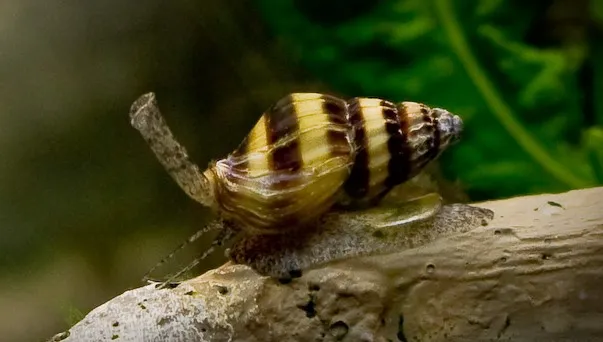
Most fish keepers keep assassin snails if they have a snail infestation problem. These species are excellent at hunting other snails since they are good at burrowing, and extremely active during nighttime. Here is more information about the assassin snail:
- Scientific name: Clea Helena
- Origin: Southeast Asia (Malaysia, Thailand, Indonesia)
- Rarity: Common
- Price: Can cost from 1$ to 3$
- Care level: Easy
- Water Temperature: 20–28 °C (68–82 °F)
- pH: 7.0–8.0
- Water Hardness: 150—250 ppm
- Minimum Tank Size: 5 gallons
- Diet: Carnivorous (these species hunt and eat other aquatic snails). Assassin snails can eat other meat-based foods
- Temperament: Aggressive towards other snails, but friendly to other creatures
- Lifespan: 1-2 years
- Breeding: Assasin snails lay eggs in aquariums (usually in the substrate or some decorations)
- Size: up to 0.75 inches (1.91 cm)
These species are excellent at controlling snail populations in an aquarium. Assassin snails themselves are very slow breeders, and would definitely not overpopulate an aquarium by themselves.
Ramshorn Snail
Moving on, the ramshorn snail is considered by some people as a pest, since these species have a history of hitchhiking to other fish tanks through newly added plants or decorations. Some people love them, others hate them.

Personally, I believe, that ramshorn snails are unique species, that are fun to watch and overall keep. There are a lot of different ramshorn snail colors available in this hobby, and most of them are relatively easy to come by. Here is more information about these species:
- Scientific name: Planorbidae
- Origin: Freshwater worldwide habitats (North, South America, Africa, Europe, Asia)
- Rarity: Common, but some ramshorn snail colors are rarer than others
- Price: Ramshorn snails can cost from 0.5$ to 5$
- Care level: Easy
- Water Temperature: 18–28 °C (65–82 °F)
- pH: 7.0–8.0
- Water Hardness: 150—250 ppm
- Minimum Tank Size: 5 gallons
- Diet: Omnivorous (can eat anything that they can find, including plant matter, leftover fish food, and decaying tank mates)
- Temperament: Very peaceful
- Lifespan: Up to 1 year
- Breeding: Every ramshorn snail has female and male reproduction organs. As long as there is more than 1 ramshorn snail in an aquarium, these species will multiply quickly
- Size: up to 1 inch (2.5 cm)
Giant Colombian Ramshorn Snail
Nearly double the size of a regular ramshorn snail is the giant Colombian ramshorn snail. It is a unique snail species, that originate from South and Central America.

The giant Colombian snail is a very beautiful snail. It has brown, white, and black stripes that go across the whole shell. Unlike regular ramshorn snails, there is only one type of coloration, when it comes to giant Colombian ramshorn snails. Here is more information about these species:
- Scientific name: Marisa cornuarietis
- Origin: South and Central America (Colombia, Brazil, Venezuela)
- Rarity: Common
- Price: Can cost anywhere from 2$ to 5$ per snail
- Care level: Easy
- Water Temperature: 20–28 °C (68–82 °F)
- pH: 7.0–8.0
- Water Hardness: 100—250 ppm
- Minimum Tank Size: 10 gallons
- Diet: Eats algae, leftover fish food, decaying plants, deceased tank mates
- Temperament: Very peaceful
- Lifespan: Up to 3 years
- Breeding: These species breed very quickly, by laying egg clusters anywhere in the tank
- Size: up to 2 inches (5 cm)
One thing to keep in mind is that these species are already known as invasive in other regions apart from South and Central America. This is the cause of aquarium trade, and improper handling of these snails, so be sure not to let these species in the wild.
Pond Snail
Another common and widely available snail, that happens to be considered by many to be a pest, is the basic pond snail. These species are one of the most common species in the fishkeeping hobby.

Many people don’t like pond snails, because they randomly appear in your aquarium. They simply get their way into a tank through newly added plants or decorations. These species quickly populate, and are some of the most basic snails in terms of appearance. Here is more information about the pond snail:
- Scientific name: Lymnaeidae
- Origin: Various worldwide freshwater habitats (lakes, rivers, ponds)
- Rarity: Common
- Price: Can cost anywhere from 0.25$ to 1$
- Care level: Easy
- Water Temperature: 18–24 °C (64–75 °F)
- pH: 7.0–8.0
- Water Hardness: 150—250 ppm
- Minimum Tank Size: 5 gallons
- Diet: Pond snails mainly eat decaying plant matter and algae, but in an aquarium, they will certainly eat leftover fish food
- Temperament: Very peaceful
- Lifespan: Up to 3 years
- Breeding: Pond snails simply lay eggs wherever they can, and under favorable conditions, those eggs hatch
- Size: up to 1 inch (2.5 cm)
These species can actually be a hassle if the population is large in an aquarium. Pond snails breed quickly, and getting rid of all of them is usually a hard job. Many people use these snails as food for pea puffers or assassin snails, but they can also be a pet if you are willing to keep them.
Malaysian Trumpet Snail
Moving on, another relatively common and small snail is the Malaysian trumpet snail. Similar to pond snails, these species can randomly appear in an aquarium through newly introduced aquatic plants or decorations.
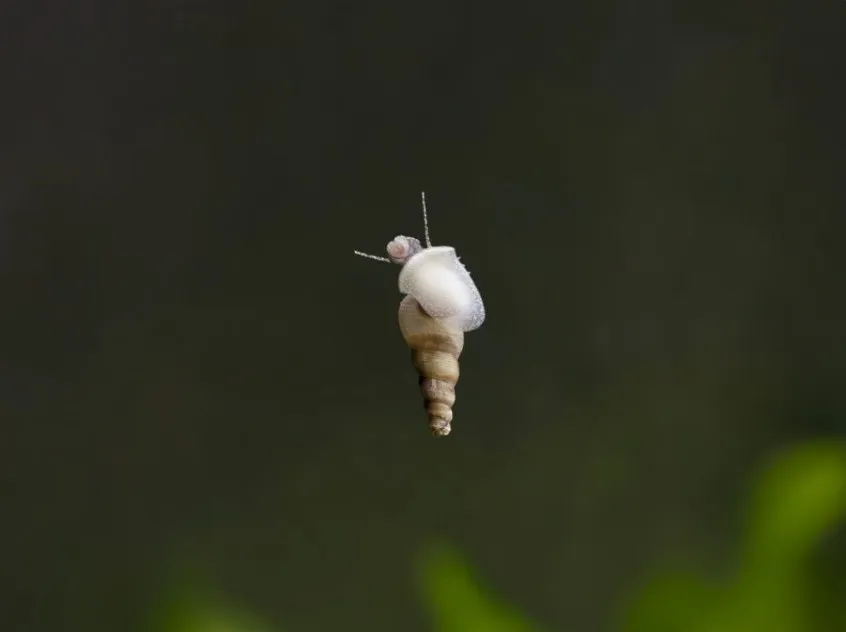
These species have a conical shell, that resembles a trumpet, hence the name. In terms of appearance, Malaysian trumpet snails are really basic, and some fishkeepers consider them pests. Here is more information about these species:
- Scientific name: Melanoides tuberculata
- Origin: Southeast Asia
- Rarity: Common
- Price: Can cost anywhere from 0.25$ to 1$
- Care level: Easy
- Water Temperature: 20–28 °C (68–82 °F)
- pH: 7.0–8.0
- Water Hardness: 150—250 ppm
- Minimum Tank Size: 5 gallons
- Diet: Omnivorous (leftover fish food, algae, decaying plants, or tank mates)
- Temperament: Very peaceful
- Lifespan: 1-2 years
- Breeding: These species easily breed in almost any conditions and can quickly grow in numbers
- Size: up to 1 inch (2.5 cm)
Malaysian trumpet snails also portray burrowing behavior. They completely disappear during the day, and become extremely active during the night. It is a natural instinct, that helps these species avoid predators.
Japanese Trapdoor Snail
One of the more interesting species on this list is the Japanese trapdoor snail. This snail originates from Southeast Asia and is becoming more and more popular in the fishkeeping hobby.

Just as the name describes, this snail has a hard plate-like disk, that seals the entrance to the shell, completely protecting the snail from any sort of predators. Here is more information about this snail:
- Scientific name: Cipangopaludina japonica
- Origin: East Asia (Japan, regions of China, and Korea)
- Rarity: Common
- Price: Usually sold for between 2$ and 5$
- Care level: Easy
- Water Temperature: 15–30 °C (59–86 °F)
- pH: 7.0–8.0
- Water Hardness: 100—250 ppm
- Minimum Tank Size: 5 gallons
- Diet: Mainly herbivorous (consumes algae and decaying plants), but can also eat fish food
- Temperament: Very peaceful
- Lifespan: Up to 4 years
- Breeding: The snails are considered livebearers, which means that Japanese trapdoor snails don’t lay eggs. These species give birth to baby snails
- Size: up to 2 inches (5 cm)
These species can also come in different colors: brown, black, gray, and yellow. Some of the snails can even have blue coloration on their shells, similar to the picture included in this article. Another cool thing about Japanese trapdoor snails is that these species can tolerate colder waters, making them more resilient than other snails mentioned on this list.
Bladder Snail
Moving on, the last considered pest snail on this list is the common bladder snail. Similar to the pond and Malaysian trumpet snails, these species unexpectedly appear in an aquarium and are unwelcome by some fish keepers.

- Scientific name: Physella acuta
- Origin: Some believe, that bladder snails originate from Europe, but there is also an argument, that these species came from North America. Right now they are globally available everywhere
- Rarity: Common
- Price: 0.25$-1$ per snail
- Care level: Easy
- Water Temperature: 18–28 °C (64–82 °F)
- pH: 7.0–8.0
- Water Hardness: 100—250 ppm
- Minimum Tank Size: 5 gallons
- Diet: These small snail species can eat anything, that they can find in an aquarium, including algae, decaying plants, leftover fish food, deceased tank mates
- Temperament: Very peaceful
- Lifespan: Up to 1 year
- Breeding: These species simply lay clusters of eggs, which result in a very fast-growing bladder snail population
- Size: up to 0.5 inches (1.2 cm)
These species get their name because of a bubble-like structure near their gills, that can sometimes resemble a bladder. Some believe, that this structure helps them regulate buoyancy.
White Wizard Snail
One of the rare and less popular snail species is the white wizard snail. This freshwater snail originates from Southeast Asia, and is slowly becoming more and more popular in this hobby, but still is not widely available globally.

The white wizard snail is a unique type of snail, which has a shell, that resembles a wizard hat. They may come in different colors (gray, brown), but the main color of their shell is white. Here is more information about these species:
- Scientific name: Filopaludina martensi
- Origin: Southeast Asia (Malaysia, Thailand, Laos, Vietnam)
- Rarity: Rare
- Price: Can cost from 3$ to 8$ per snail
- Care level: Easy
- Water Temperature: 23–26 °C (73–79 °F)
- pH: 7.0–8.0
- Water Hardness: 100—200 ppm
- Minimum Tank Size: 5 gallons
- Diet: Mainly eats algae, but can eat fish food, blanched vegetables
- Temperament: Very peaceful
- Lifespan: 2-4 years
- Breeding: These species are very slow breeders, and don’t lay eggs. Instead, white wizard snails give birth to their babies
- Size: up to 2 inches (5 cm)
The body of the white wizard snail is dark in color and usually can have brown or yellow spots covered all around the body. In nature, these species mainly live in ponds, rivers, and canals.
Black Devil Spike Snail
Moving on, another rare aquarium snail is the black devil spike snail. These species are extremely beautiful and way more expensive than the more available snail species in this hobby.

The black devil spike snail has its name because of its appearance. The shell of the snail is long and pointy, and the color is mainly black but sometimes white, red, or orange colorations. The surface of the shell is smooth. Here is more information about this snail:
- Scientific name: Faunus Ater
- Origin: Philippines, India, Taiwan
- Rarity: Rare
- Price: Can cost from 4$ to 8$ per snail
- Care level: Easy
- Water Temperature: 23–28 °C (73–82 °F)
- pH: 7.0–8.0
- Water Hardness: 100—200 ppm
- Minimum Tank Size: 5 gallons
- Diet: Mainly eats decaying plant matter, algae, leftover fish food
- Temperament: Very peaceful
- Lifespan: Up to 5 years
- Breeding: These species can’t breed in freshwater, and overall the process of breeding is largely unknown
- Size: up to 3 inches (7.62 cm)
The body of the black devil spike snail is also dark in color and sometimes can have white, red, or yellow spots on the skin. Because of the coloration of this snail, it is better to keep it in lighter tank setups, since it would be easier to see your snail and examine it.
Chopstick Snail
Another long and pointy snail, that is more uncommon than the others is the chopstick snail. These species can sometimes be hard to come by since they are fairly new to this hobby.

The chopstick snail got its name based on its appearance. The shell of the snail is long, and is usually brown, resembling a chopstick. Every individual chopstick snail can vary in color, and some can portray white, dark, and brown coloration with stripes. Here is more information about these species:
- Scientific name: Stenomelania torulosa
- Origin: India, Taiwan, Philippines
- Rarity: Rare
- Price: Can cost between 3$ and 8$ per snail
- Care level: Easy
- Water Temperature: 24–27°C (75–80°F)
- pH: 7.0–8.0
- Water Hardness: 100—200 ppm
- Minimum Tank Size: 5 gallons
- Diet: Eats algae, but also likes fish food, decaying plant matter
- Temperament: Very peaceful
- Lifespan: Up to 5 years
- Breeding: Relatively unknown, since these species are new to the aquarium hobby
- Size: up to 4 inches (10 cm)
These species are very rare and hard to breed. The main way they are being introduced into fish keeping is through being caught in the wild, not by being bred in captivity. Because of that, chopstick snails can be really pricy if you can come by any.
Prambanan Snail
Moving on, the prambanan snail is also one of the rare aquatic snails on this list. Only a few online snail shops do occasionally have these snails for purchase, but nevertheless, these species are extremely rare, and the name of the snail comes from resembling a tower from the Prambanan temple.

Prambanan snails are similar in appearance to the Malaysian trumpet snails, but only are slightly larger and have thorns on their shell. Some argue, that captivity-bred prambanan snails lose thorns, but it is probably a situational case, and not proven scientifically. Here is more information about these species:
- Scientific name: Thiara winteri
- Origin: Indo-Pacific region
- Rarity: Rare
- Price: Can range from 3$ to 7$ per snail
- Care level: Easy
- Water Temperature: 22–28 °C (72–82 °F)
- pH: 7.0–8.0
- Water Hardness: 100—250 ppm
- Minimum Tank Size: 5 gallons
- Diet: Omnivorous (can eat blanched vegetables, algae, blood worms, leftover food)
- Temperament: Very peaceful
- Lifespan: 1-2 years
- Breeding: These species are live-bearers, and release the babies, once they are enough matured
- Size: up to 1.5 inches (4 cm)
Prambanan snails have a unique coloration, their shell can be a mix of brown, white, red, and black. Similar to Malaysian trumpet snails, these species also enjoy burrowing themselves into the substrate, and only becoming more active during the night.
Pagoda Snail
Another rare and beautiful snail on this list is the pagoda snail or horned armor snail. These species are actually endangered in the wild, and it is best that they are only bought from local breeders instead of being caught in the wild.

The shell of the pagoda snail is very unique, the color is usually dark or light brown, and there are a lot of different size spikes all around the shell, similar in appearance to a porcupine. Here is more information about the pagoda snail:
- Scientific name: Brotia pagodula
- Origin: Southeast Asia (Thailand, Malaysia, Indonesia)
- Rarity: Rare
- Price: Can cost from 5$ to 15$ per snail
- Care level: Easy
- Water Temperature: 22–28 °C (72–82 °F)
- pH: 7.0 – 8.0
- Water Hardness: 100—250 ppm
- Minimum Tank Size: 5 gallons
- Diet: Omnivorous (can eat algae, decaying plants, fish food, blanched vegetables)
- Temperament: Very peaceful
- Lifespan: 1-2 years
- Breeding: These species are also livebearers, and give birth to 10-20 babies once per year
- Size: up to 1.5 inches (4 cm)
The body of the pagoda snail is usually dark, but there are cases where the snail also has dots all over the body, which are usually yellow or orange in color. These species also love to burrow themselves into the substrate, which makes them excellent snails if you are looking to aerate your aquarium substrate.
Black Trumpet Snail
The last snail on this list is the black trumpet snail. It looks very similar to the chopstick and the black devil snail, but it is a whole different species.

The black trumpet snail can come in different colors: brown, black, grey, and white. It can also have multiple colors, making it more interesting. The main difference between the black trumpet snail and the black devil or the chopstick snail, is the shape of the shell. The black trumpet snail has a shell, which has a spiral form. Here is more information about these species:
- Scientific name: Melanoides maculata
- Origin: Southeast Asia (Malaysia, Indonesia, Thailand)
- Rarity: Common
- Price: Can cost from 4$ to 7$ per snail
- Care level: Easy
- Water Temperature: 22–28 °C (72–82 °F)
- pH: 7.0–8.0
- Water Hardness: 100—250 ppm
- Minimum Tank Size: 5 gallons
- Diet: Mainly eats algae, leftover fish food, decaying plant matter
- Temperament: Very peaceful
- Lifespan: 1-2 years
- Breeding: These species simply lay eggs on the substrate or anywhere else in an aquarium, which usually hatch
- Size: up to 1.5 inches (4 cm)
These species are also more rare than the most common snails on this list. The black trumpet snail also behaves in a similar way to the Malaysian trumpet snail. It becomes more active during the night and loves to burrow itself during the day.
Frequently Asked Questions
Are Snails Good For Fish Tanks?
Aquarium snails are really beneficial to fish tanks since they help eat all the leftover food, battle algae, and in general keep the aquarium clean. Most aquarium snails are beautiful, so it is also aesthetically beneficial to keep them.
Do Aquarium Snails Need Air?
Most aquarium snails breed through their gills in the water, but some have the capability to breathe air. If there is oxygen in the water, your aquatic snails will be fine. It is important to have an airstone and a filter so that the water keeps getting moved around and oxygen levels won’t drop.
Writer's Thoughts
Aquatic snails are so amazing and provide a lot of different positive things to a healthy aquarium. Researching the different types of aquarium snails really broaden my knowledge, of just how many snail species are there. Make sure to get some aquarium snails for your tank!
If you enjoyed reading our article, please feel free to share it with your friends by clicking the social media buttons below:

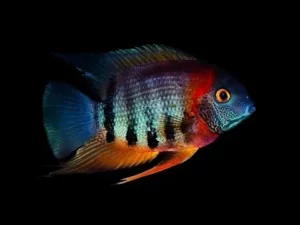
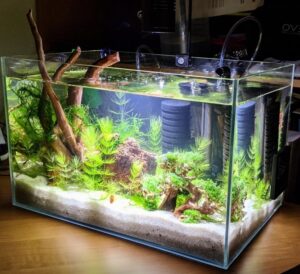

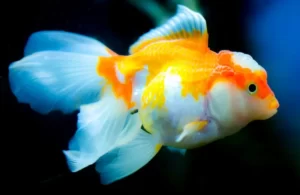
Goldfish With Bump On Head: Possible Causes, Dangers & Treatments
